Source (Google.com.pk)
Pakistani Brides Dresses Biography
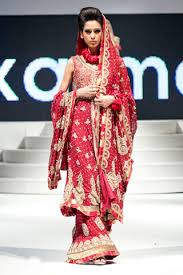
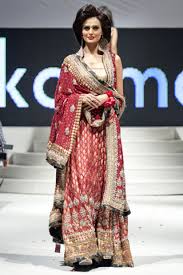
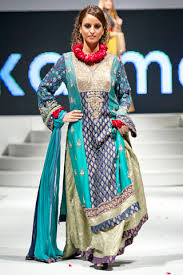
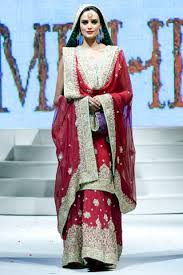
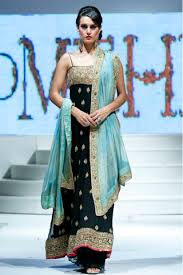



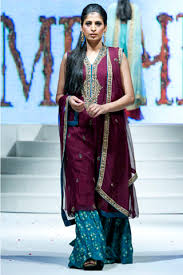
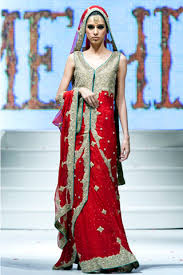

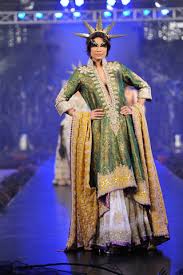
Pakistani Brides Dresses Biography
Models were dolled up in the attire of eastern delicacy and roses as they walked the stage with utmost respect and grace of culture reflected in their heavily embroidered bridal creations designed by Karma.
All the dazzlingly beautiful shades of red, maroon, green, Mehndi, beige were delicately woven, keeping in mind traditional aesthetics and cultural grace at Allenora Bridal Show by Karma.
Mesmerizing embellishments of Zardozi, sequins, dubka, beads and semi precious stones added to the beauty of bridal creations by Karma.
Pakistani women have variety of traditional dresses other than Shalwar Kameez but they mostly wear them in special occasions like Wedding, Engagement, Mehndi and other traditional ceremonies. Among these dresses Saris are very popular and its each design and color seems unique from the other e.g. Lehenga Style Sari. Lehenga is another popular dress which resembles with skirt but a typical traditional dress. Gharara and Sharara are two resembling dresses which are often used in ceremonies. Farshi Pajama is an old traditional dress which is worn occasionally. Laacha is worn in Eastern part of the country, its a dress which resembles with Dhoti from its lower part.
In regional clothing, Balochi women wear heavy embroided Shalwar Kameez and Dupatta according to the weather conditions. They wear Kameez full of heavy Embroided Shisha work. Sindhi costumes have different styles of embroidery and some women use Ajrak as Dupatta. these women also wear bangles in their traditional way. Punjabi women prefer lite embroidery on simple Shalwar Kameez or Kurta. Traditional Lacha and Bangles are also used. Paranda is the special traditional, colorful and unique Punjabi item which is used to tie the hair. Pathan women wear embroided Kameez with a farak with a heavy Dupatta.
By women's religious clothing we mean the dressing in which they try to cover all their body parts except face and hands while going outside from their home.Mostly women cover their heads with Dupatta or Chadar in outdoors but religious women prefer to wear Scarf, Burqa or Hijab and wear lose, long and full sleeve shirts.
With the passage of time Pakistani women has started to adapt new styles some of which are the combination of Pakistani and Western clothing. Like women wear Embroided Kurta with Jeans and Trousers. Tight half sleeve and sleeveless shirts with Capri trousers have also been adopted.
Suits are made in a variety of fabrics, but most commonly from wool. The two main yarns produce worsteds (where the fibres are combed before spinning) and woollens (where they are not). These can be woven in a number of ways producing flannel, tweed, gabardine, and fresco among others. These fabrics all have different weights and feel, and some fabrics have an S (or Super S) number describing the fineness of the fibres. Although wool has traditionally been associated with warm, bulky clothing meant for warding off cold weather, advances in making finer and finer fiber have made wool suits acceptable for warmer weather, as fabrics have accordingly become lighter and more supple. For hot weather, linen is also used, and in North America cotton seersucker is worn. Other materials are used sometimes, such as cashmere. Silk and silk blended with wool are sometimes used. Synthetic materials, while cheap, are very rarely recommended by experts.
All the dazzlingly beautiful shades of red, maroon, green, Mehndi, beige were delicately woven, keeping in mind traditional aesthetics and cultural grace at Allenora Bridal Show by Karma.
Mesmerizing embellishments of Zardozi, sequins, dubka, beads and semi precious stones added to the beauty of bridal creations by Karma.
Pakistani women have variety of traditional dresses other than Shalwar Kameez but they mostly wear them in special occasions like Wedding, Engagement, Mehndi and other traditional ceremonies. Among these dresses Saris are very popular and its each design and color seems unique from the other e.g. Lehenga Style Sari. Lehenga is another popular dress which resembles with skirt but a typical traditional dress. Gharara and Sharara are two resembling dresses which are often used in ceremonies. Farshi Pajama is an old traditional dress which is worn occasionally. Laacha is worn in Eastern part of the country, its a dress which resembles with Dhoti from its lower part.
In regional clothing, Balochi women wear heavy embroided Shalwar Kameez and Dupatta according to the weather conditions. They wear Kameez full of heavy Embroided Shisha work. Sindhi costumes have different styles of embroidery and some women use Ajrak as Dupatta. these women also wear bangles in their traditional way. Punjabi women prefer lite embroidery on simple Shalwar Kameez or Kurta. Traditional Lacha and Bangles are also used. Paranda is the special traditional, colorful and unique Punjabi item which is used to tie the hair. Pathan women wear embroided Kameez with a farak with a heavy Dupatta.
By women's religious clothing we mean the dressing in which they try to cover all their body parts except face and hands while going outside from their home.Mostly women cover their heads with Dupatta or Chadar in outdoors but religious women prefer to wear Scarf, Burqa or Hijab and wear lose, long and full sleeve shirts.
With the passage of time Pakistani women has started to adapt new styles some of which are the combination of Pakistani and Western clothing. Like women wear Embroided Kurta with Jeans and Trousers. Tight half sleeve and sleeveless shirts with Capri trousers have also been adopted.
Suits are made in a variety of fabrics, but most commonly from wool. The two main yarns produce worsteds (where the fibres are combed before spinning) and woollens (where they are not). These can be woven in a number of ways producing flannel, tweed, gabardine, and fresco among others. These fabrics all have different weights and feel, and some fabrics have an S (or Super S) number describing the fineness of the fibres. Although wool has traditionally been associated with warm, bulky clothing meant for warding off cold weather, advances in making finer and finer fiber have made wool suits acceptable for warmer weather, as fabrics have accordingly become lighter and more supple. For hot weather, linen is also used, and in North America cotton seersucker is worn. Other materials are used sometimes, such as cashmere. Silk and silk blended with wool are sometimes used. Synthetic materials, while cheap, are very rarely recommended by experts.
Pakistani Brides Dresses
Pakistani Brides Dresses
Pakistani Brides Dresses
Pakistani Brides Dresses
Pakistani Brides Dresses
Pakistani Brides Dresses
Pakistani Brides Dresses
Pakistani Brides Dresses
Pakistani Brides Dresses
Pakistani Brides Dresses
Pakistani Brides Dresses
Pakistani Brides Dresses
Pakistani Brides Dresses
No comments:
Post a Comment